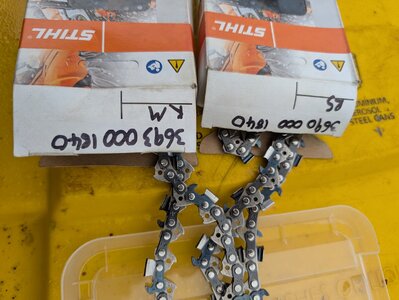Squish9
Pinnacle OPE Member
- Local time
- 2:13 AM
- User ID
- 28596
- Joined
- Feb 27, 2024
- Messages
- 331
- Reaction score
- 1,465
- Location
- Australia
Thanks for the red mark on my forehead. I read this the other day but it didn't really click till 10 minutes ago and I face palmed myself pretty good.If you're looking for as much consistency as possible between sharpening with a file and a saw chain grinder, you can try to dress the wheel to match the size of the file you prefer to use. This is what Stihl recommends for their grinders.
I think that by seeing these instructions and pics you will get the idea.
View attachment 436035
This dressed (rounded) part is in contact with the top plate during grinding.
View attachment 436041
In addition, some grinders equipped with a tilting vise have auxiliary markings for a small correction of the cutting & top sharpening angle when the vise is tilted.
View attachment 436039
You really don't need a sliding vise to get good results. It is more useful for corrections related to wear of the wheel and reduction of its diameter.
511AX, although it also has a sliding vise, uses the tilt to set the "10° down angle".
Grinders (e.g., 620, Jolly Evo) that do not have a tilting vise, but do have a sliding vise, can have a scale in degrees 15-0-15 for the down angle. The USG has a scale in millimeters, and I think it may have a mistake (not the first one) in the chart when it comes to the direction of moving the vise (or we misunderstand the chart).
For me, the most important parameter I can control is how low I lower the wheel. This determines the cutting angle and side plate obtained. By lowering the wheel lower you get sharper angles and more hook. Knowing this, you can get good results even on grinders like the 310 and its cheap copies.
Very expensive automatic grinders have neither a tilting nor sliding vise.
You usually only set on them the top plate sharpening angle, the cutting angle and how deep the wheel goes down.
I knew I didn't know much about using a grinder but didn't think I was that stupid untill now. Just played around with the grinder for a few minutes and, yep, it all works exactly how you described.
I always used the profiled section of the wheel to form the lower part of the side plate and the flat section of the wheel to form the top plate and upper section of the side plate. Essentially having a 55-60 straight side plate. Using the profiled section allows the angles to be tweaked to whatever you want. Not sure how I didn't know this

























